
Winter 2017 issue of Florida Golf Magazine features "The Florida Golf Architecture of Arthur Hills" Click here to read it.

Written by Golf Course Designer, Pete Dye for Florida Golf Magazine

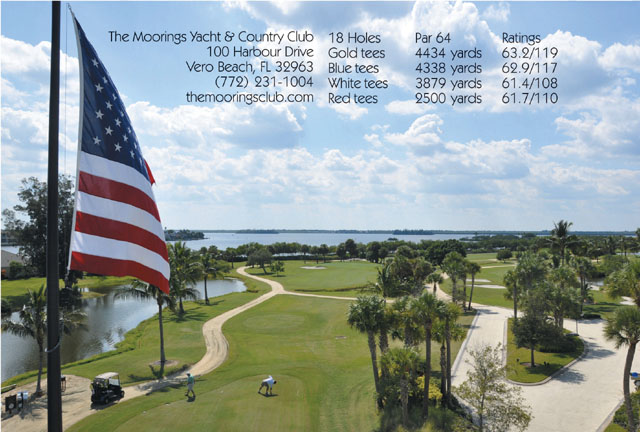 At the Moorings Yacht & Country Club the first fairway to the 163 yard par 3 has a pretty little stream that runs across the fairway and up along the right side of the green.
At the Moorings Yacht & Country Club the first fairway to the 163 yard par 3 has a pretty little stream that runs across the fairway and up along the right side of the green.
|
The Moorings Yacht & Country Club Course Designer: Pete Dye, ASGCA 18 Holes, Par 64, Year Opened - 1974 |
||
|
Tees: Gold Blue Red Green |
Yards: 4434 4338 3879 2500 |
Rating / Slope 63.2 / 119 62.9 / 117 61.4 / 108 61.7 / 110 |

 The Moorings Yacht & Country Club in Vero Beach, Florida is the only short golf course I have ever built during my fifty year career as a golf course designer, and I am extremely proud of how it turned out.
The Moorings Yacht & Country Club in Vero Beach, Florida is the only short golf course I have ever built during my fifty year career as a golf course designer, and I am extremely proud of how it turned out.
Back in 1974 Jorge Gonzalez, who would later become Club President of The Moorings Club hired me to design and build this 18-hole golf course on 70 acres of property that included a large barren yet unspoiled peninsula that jutted out into the middle of the beautiful Indian River Lagoon.
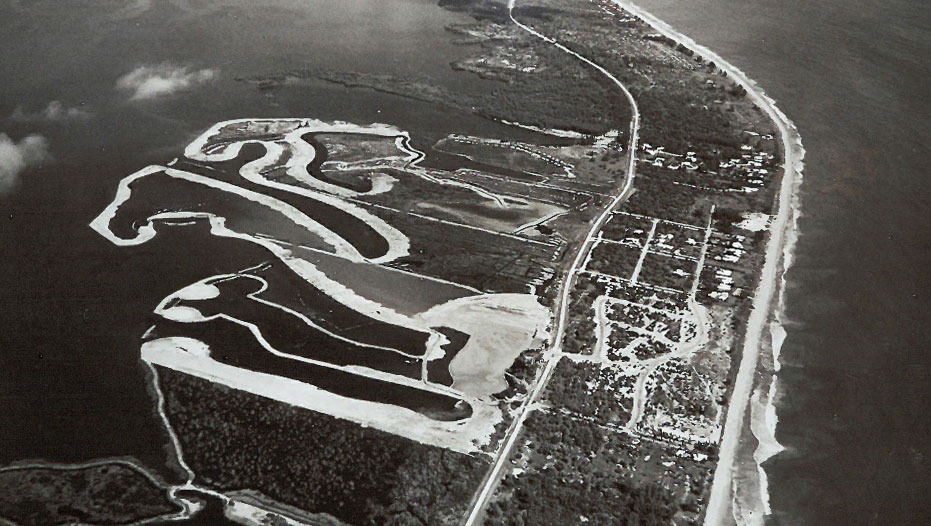 Purchased in the late 1950’s by Julio Lobo, a Cuban sugar baron and father of Leonor Lobo-de-Gonzalez, the unusable acreage was dredged on a massive scale and the fill piled high to create fingers of land reinforced by eight miles of sea wall. The Moorings was originally designed and created to be a boating community.
Purchased in the late 1950’s by Julio Lobo, a Cuban sugar baron and father of Leonor Lobo-de-Gonzalez, the unusable acreage was dredged on a massive scale and the fill piled high to create fingers of land reinforced by eight miles of sea wall. The Moorings was originally designed and created to be a boating community.
The front nine holes which we built on the peninsula are totally surrounded by the Indian River Lagoon, which is the most bio-diverse estuary in all of North America. Of the 5000 manatees that live in the state of Florida, one-third of them live in the Indian River Lagoon. Over 4500 species of plants and animals including 700 species of fish also call it home.
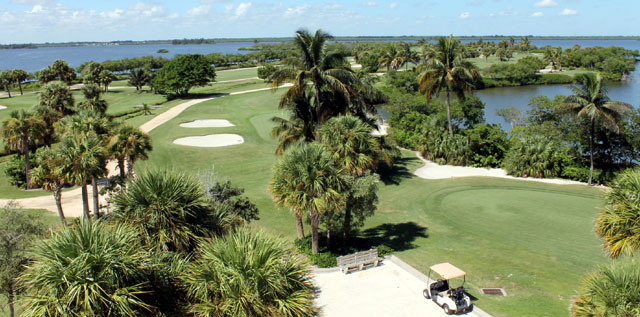 The front nine holes at The Moorings Yacht & Country Club in Vero Beach are built on the peninsula and are totally surrounded by the Indian River Lagoon
The front nine holes at The Moorings Yacht & Country Club in Vero Beach are built on the peninsula and are totally surrounded by the Indian River Lagoon
I must’ve had a vision back in 1974 because it seems like I built the golf course of the future at The Moorings Club. Built 40 years before today’s Tee It Forward initiative, you can “play faster and have more fun” at The Moorings Club without having to “tee it forward” because the normal recommended USGA Pace of Play for the 4434 yard back tees (without hurrying) is only 3 hours and 25 minutes.
The course at The Moorings Club is very playable from the front tees, but my plan for the back-tees was to test the best players’ shot-making skills over the entire 18 holes. This course is not always about hitting that big long drive; it’s more often about the placement of your shot and playing smart. With only 70 acres to work with I think we did a good job of using every square inch efficiently, with small greens, tight fairways, and 16 holes on the water. All of the holes are well placed, you have nine par threes, eight par fours and one par five, and you basically use every club in your bag.
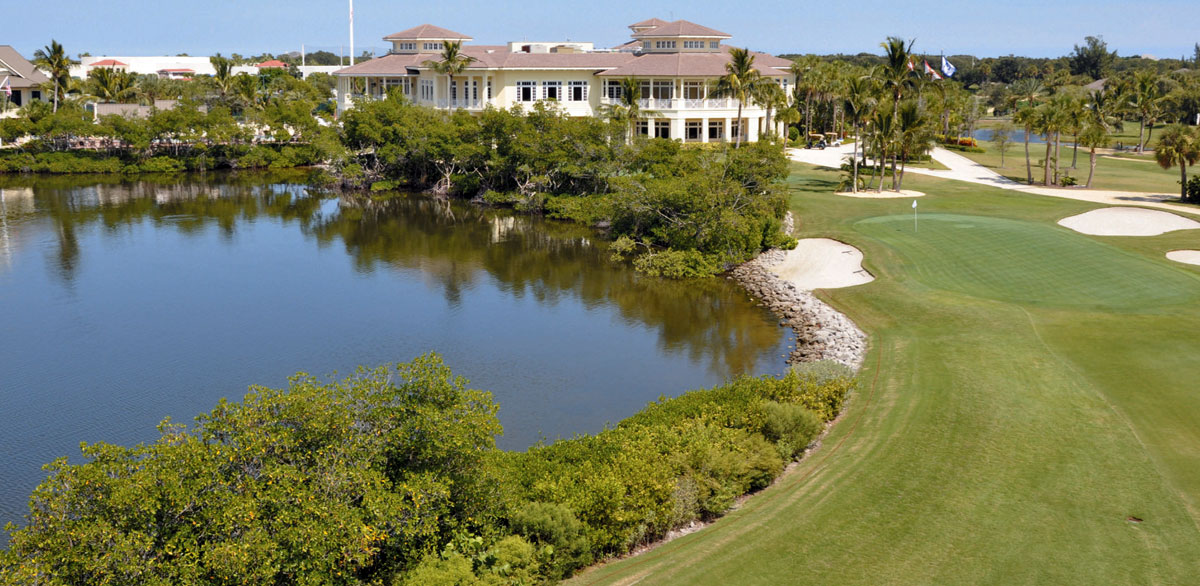 The ninth hole at The Moorings Yacht & Country Club is a beautiful 156-yard par 3 over the Lagoon, toward the clubhouse.
The ninth hole at The Moorings Yacht & Country Club is a beautiful 156-yard par 3 over the Lagoon, toward the clubhouse.
This course is a jewel, and over the last 40 years my appreciation for the diverse wildlife that lives here has deepened. I took great delight in designing this course and seeing how it has matured and held its character.
This little Par 64 golf course always helps to remind me that golf is more than just a game. And we are not just golf course designers and builders, but are also responsible stewards of the environment.
Keeping up with the times, The Moorings Club has also resurfaced their greens with TifEagle bermuda-grass, and the Superintendent usually keeps the green-speed fast, stimping at around 9-1/2 to 10 inches of roll. Plus, back in 2003 they removed 98% of all the invasive exotic species of trees and plants from the course and replaced them with native species. Now, ten years later the native trees and plants like the Sable Palms, Green Buttonwood and Sea Grapes have grown, so now it looks very much like “old Florida.” In my opinion, it looks perfect!
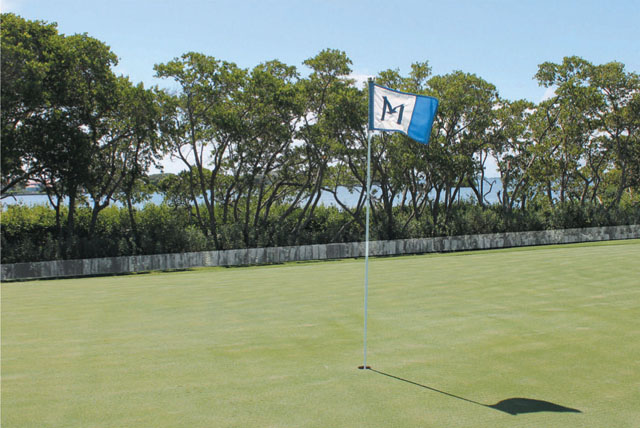 These railroad ties along the 3rd green were installed by Pete Dye back in 1975.
These railroad ties along the 3rd green were installed by Pete Dye back in 1975.
Another environmentally friendly practice that The Moorings Club has adopted is maintaining a buffer zone of taller grass around all the aquatic features on the course. This has multiple benefits besides stopping your ball from rolling in the water, such as stopping grass clippings or anything else that might want to roll down into the ponds. Also, all that tall grass is creating habitat.
You’ll notice all of the wading birds that like to walk around in the grasses looking for insects, bugs, and small fish. And the grasses that are hanging over the water creating shade are providing another habitat for those fish that live along the edge. They’ll get underneath those grasses and hide and then dart out to get their food, back and forth while the birds watch them from above.
About 100 years ago, golf course architect Alister MacKenzie said, “The chief object of every golf architect or green keeper worth his salt is to imitate the beauties of nature so closely as to make his work indistinguishable from Nature herself.” So, with that in mind, I’d say the closer we continue to mimic nature at The Moorings Club, the more beautiful it is, plus the easier it is to maintain. - Pete Dye
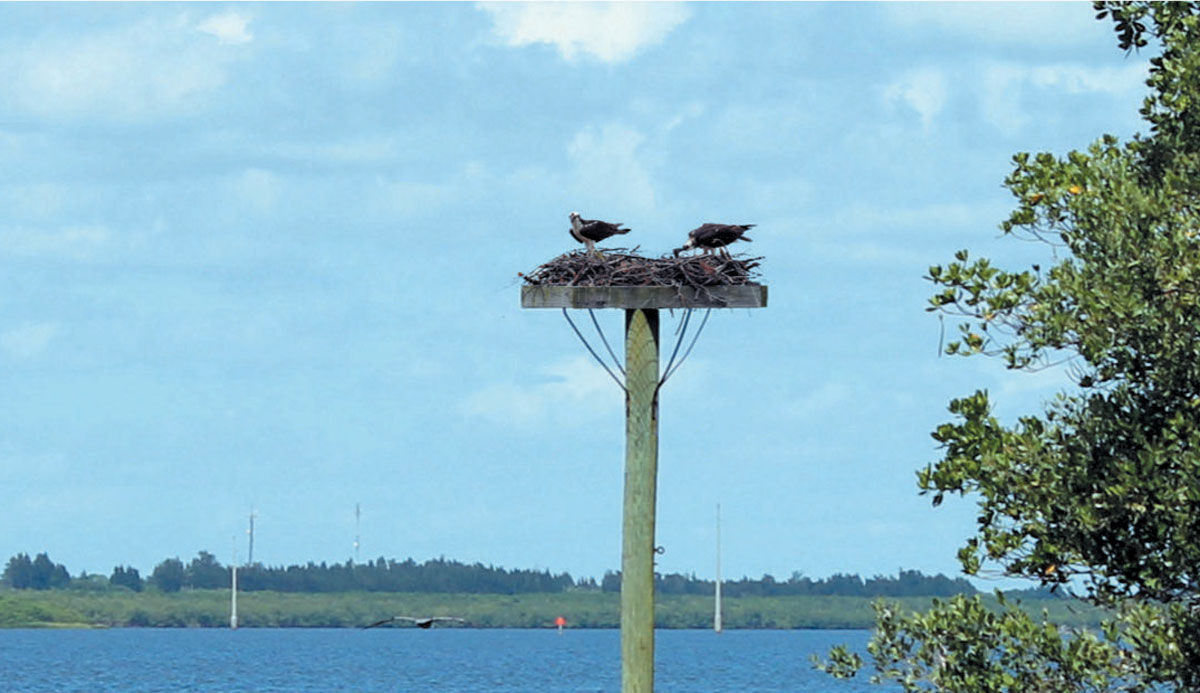 A family of Osprey live and fish on the golf course at The Moorings Yacht & Country Club in Vero Beach, Florida
A family of Osprey live and fish on the golf course at The Moorings Yacht & Country Club in Vero Beach, Florida

Pete Dye’s Design Notes: - The Moorings Yacht & Country Club in Vero Beach, FloridaHole #1: Par 3, Hndcp 13, Gold 163, Blue 163, White 153, Red 115The first hole at The Moorings Club is a great little starting hole. This par 3 is 163 yards in length from the back tees and looks easy. The first fairway runs southwest with water left of the tee and a pretty little stream that runs across the fairway and up along the right side of the green. If you’re a nature lover, you might snap a photo of the beautiful pink Roseate Spoonbills that often feed in the pond left of the first tee. But don’t relax; because the first green is fast and tricky. Hole #2: Par 4, Hndcp 15, Gold 277, Blue 277, White 266, Red 242With a long narrow waste bunker and a magnificent view of the vast Indian River Lagoon along the entire left side of the fairway, number two is a par 4 and it’s not too long, about 290 yards. Of course when the good players are here they’re going to want to drive the green, but in my opinion that’s about the worst approach you can take because it’s really hard to hit such a small green. The best way to play the hole is to just hit a shot out about 190 yards or so and then another hundred yard shot to the hole. Since the green is small any second shot on the green leaves you with a legitimate birdie putt. One of the trademarks at The Moorings Club is the many long, narrow waste bunkers (or “seasides”, as I like to call them) that I built around the exterior of the front nine on the peninsula. Backed by mangroves, these attractive little waste areas allowed us to use every square inch of land right up against the edge of the lagoon as playable hazard. Besides framing some of the most scenic riverside vistas found at any Florida golf course, public or private, the sand in these seaside waste areas also serves as habitat for wildlife such as the Fiddler Crab. The Golf Course Superintendent at The Moorings Club, Craig Weyandt, who just happens to be a “Certified Master Naturalist”, says that if he did not maintain those seaside waste areas, keeping their sand raked and free of weeds and other vegetative material, the fiddler crabs would lose them as habitat. So, The Moorings Club is purposely maintaining habitat for the fiddler crab. The “seasides” are left of holes 2, 3, 4, 6, 7, 8 on the front nine. In the Fall, September, October and November are typically the wet months for The Moorings Club. When the conditions are right, the water level of the Indian River Lagoon rises and the seaside waste bunkers fill up with a few inches of water, which really looks beautiful. Hole #3: Par 4, Hndcp 1, Gold 404, Blue 383, White 320, Red 278In my opinion, the third hole is undoubtedly the hardest hole at The Moorings Club, and judging by the way it’s rated on the scorecard, it might very well be the hardest hole in Indian River County. It’s a 400-yard par 4 with an elevated green that has a slight ridge running right down the middle. So if you hit the right side of the green it can bounce off to the right, and if you hit the left side it might bounces left. Being both very difficult to putt and well bunkered and with water both left and right of the green, my approach to this hole is never to worry about where the flag is. Instead just try to get it on the front of the green. Then if you can make it in two putts and get out of there, that’s a great way to play the 3rd hole. Running along the entire left side of the third hole is another long and narrow seaside waste area backed by vertical lined railroad ties, mangroves and the lagoon. Every morning typically around 6:30 a.m. you will see these short stocky birds called Yellow-crowned Night-Herons and Black-crowned Night-Herons, pulling crabs out of these seaside waste bunkers. They stand motionless over crab holes in the seaside waste areas just waiting for the crabs to come up out of their holes first thing every morning. Most people don’t know that Fiddler Crabs must breathe through water. Even though the crabs are terrestrials, meaning they walk around up on land they still have to keep their gills wet in order to breathe. So if their gills start to dry they have to run back down in their hole where there is water at the bottom, and get their gills wet so they can breathe again. And what is really amazing about the Fiddler Crab is that its mouth parts are so small that it actually cleans the “detritus” or decaying matter off of a single grain of sand at a time. So the Fiddler Crabs at The Moorings Club are actually helping to keep the sand in the seaside waste areas clean. Hole #4: Par 3, Hndcp 9, Gold 162, Blue 162, White 139, Red 108The 4th hole is one of my favorites at The Moorings Club. It’s a 162-yard par 3. During the winter season you get a wind blowing off the ocean from the east, but the hole runs north to south, so the wind blows left to right. Running along the entire left side of the hole is a long and narrow seaside waste bunker backed by mangroves and the lagoon. When the high tide water from the lagoon raises this seaside waste area looks very pretty. If you’re a high handicapper I might recommend hitting short right of the green on hole #4. Hole #5: Par 3, Hndcp 17, Gold 89, Blue 89, White 83, Red 78The 5th hole is the short but very popular par three called Poco-Loco. Only 89 yards it’s still an intimidating forced carry. There are three holes on the front nine at The Moorings Club that have forced carries over the Indian River Lagoon, 5, 7, and 9. Hole #6: Par 4, Hndcp 5, Gold 362, Blue 362, White 330, Red 342The 6th hole, a 362-yard dogleg right, is a tough little par four called Porpoise Point and it is rated as the 3rd hardest hole at The Moorings Club. This is a beautiful golf hole with the Indian River Lagoon along the left side of the narrow fairway, and a reachable man-made lake on the right. It’s always very nice to hear members say, “I saw the dolphins playing out left of number six today.” Hole #7: Par 3, Hndcp 11, Gold 155, Blue 155, White 119, Red 105Alice (my wife and co-designer) pretty much designed the 7th hole on her own. It’s a 155 yards, par 3, with a forced carry over the lagoon from the back tees, but no real forced carry from the forward tees. There are mangroves along the water on the left. Once again, if you draw it too much you’ll be in the Indian River Lagoon. Even though the 7th green tends to slope ever-so-slightly away from the water, this is still a good hole to hit a nice little fade, because you generally get the wind off the ocean so if you fade a little, that little cut can hold its line into the green. Director of Golf, Tom Thornton, named Hole #7 Manatee Pocket because it’s a great place to spot manatees. Hole #8: Par 4, Hndcp 3, Gold 396, Blue 351, White 311, Red 263Now, hole number 8 is another really good hole. It’s a 396-yard dogleg right, par four, with trees and water on the right and the seaside waste bunkers, mangroves and the Lagoon on the left. The small 8th green slopes left toward the water here, plus you’ve got to hit over a bunker that is guarding the front of the small green. So you’re better off trying to fade your second shot onto the green, especially with the wind typically coming from the southeast on this hole. Hole #9: Par 3, Hndcp 7, Gold 156, Blue 156, White 137, Red 106The last hole of the front nine is a beautiful 156-yard par 3 over the Lagoon and toward the clubhouse. This hole is definitely one of the toughest par 3s on the course. Also, with the prevailing wind blowing in your face the 9th hole seems a lot longer than it is. Over the past 40 years, I’ve hit everything from a pitching wedge to a 4-iron on this hole, so make sure you use enough club and hit it solid. Hole #10: Par 4, Hndcp 14, Gold 260, Blue 260, White 251, Red 222The 10th hole is another very interesting hole. Tiger Woods could probably drive this 260-yard par 4 with a 4-iron, but with a pond on the right and out-of-bounds on the left I think the smart play for most golfers might be to lay-up and then hit a wedge into the small elevated green. Hole #11: Par 3, Hndcp 16, Gold 127, Blue 119, White 105, Red 75Not the toughest par 3, the 11th hole, is one of the prettiest holes on the course. With magnificent old oaks all along the left side of the hole, it’s 127 yards from an elevated tee, over the water, to a big beautiful elevated green. Hole #12: Par 4, Hndcp 6, Gold 327, Blue 327, White 315, Red 29712 is the fourth toughest hole at The Moorings Club. It’s a 327-yard par four into the prevailing wind to a treacherous green that’s bunkered in front and back. Hole #13: Par 3, Hndcp 18, Gold 123, Blue 123, White 105, Red 92The 13th hole is a 123-yard par three. It’s a cute hole, and its large green has lots of shaping and beautiful bunkering. Hole #14: Par 4, Hndcp 4, Gold 361, Blue 361, White 318, Red 302I think #14 is a fun hole. It’s pretty much straight away, with your tee shot most often hitting into a southeast wind. The second toughest hole on the course, the 361-yard par four, has out-of-bounds on the left and a forced carry over the only fresh water lake on the course. The 14th green is guarded on the front left by a large bunker. Alice and I will never forget the first time we saw a marsh rabbit swimming across this pond 40 years ago. Up to that time we had never seen or heard of rabbits swimming like that before. Hole #15: Par 3, Hndcp 8, Gold 180, Blue 158, White 116, Red 104Changing direction the 180-yard par three, 15th hole called Cutlass Cove turns north with a tee shot that is forced to carry a beautiful waste bunker to the very large, undulating, and well bunkered 15th green. Hole #16: Par 4, Hndcp 2, Gold 440, Blue 440, White 417, Red 401The 440 yard 16th hole, called “The Road Hole” is the only par five at The Moorings Club. This is a very scenic hole with a view of the water at Cutlass Cove just left of the tee and a very different view of the lagoon and Porpoise Bay up near the green. Medium length hitters are advised to aim their tee shots between two big banyan trees that are out in the middle of the 16th fairway. Though, it’s guarded by a big waste area directly in front of the green, and another bunker to the left of the green, some of longer players still manage to reach the 16th green in two only to find that the swails and hollows shaped into this challenging-but-true Tifeagle green make it a very difficult green to hold and putt. Hole #17: Par 3, Hndcp 10, Gold 146, Blue 146, White 119, Red 109The 17th hole is a par three that is 146 yards over a lake to a green that’s protected on the left by a enormous bunker, so I’d say if you’re going to miss it, miss it short right. I like #17, it’s an excellent golf hole. Hole #18: Par 4, Hndcp 12, Gold 306, Blue 306, White 275, Red 261Number 18 is a great finishing hole, and a lot of fun to play. The little island tee area hidden back amongst the oak trees makes your tee shot a forced carry over water. It’s a 306-yard par four over a lake with out-of-bounds on the left and water running all along the right side of the fairway. This is a terrific hole for putting pressure on final hole bets! |



